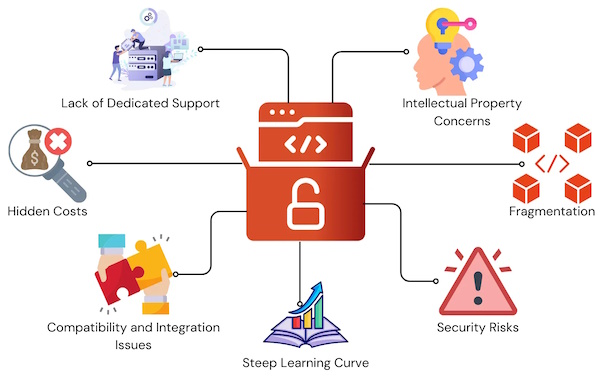Are Open Source software really cost-effective?
- Nitin Deherkar
- /
- August 26, 2024
- /
- Software

Open-source Software-as-a-Service (SaaS) platforms have gained traction for their flexibility, cost-effectiveness, and vibrant community-driven ecosystems. While these advantages are compelling, it's essential to understand the potential drawbacks before adopting open-source SaaS solutions. Here are some key disadvantages to consider:
1. Limited Customer Support
Unlike proprietary SaaS providers that offer robust customer support, open-source SaaS platforms often rely on community forums and user groups for assistance. While these communities can be resourceful, they may not provide the level of responsiveness or expertise required to resolve critical issues quickly.
2. Complex Implementation and Maintenance
Open-source SaaS platforms frequently demand a high level of technical expertise for installation, customization, and ongoing maintenance. Businesses without an experienced IT team may struggle to configure the software effectively or address issues that arise during use.
3. Security Concerns
Since open-source code is publicly available, it can be easier for malicious actors to identify vulnerabilities. Additionally, responsibility for securing the software often falls on the user, which can be daunting without proper expertise or resources.
4. Hidden Costs
While the initial cost of using open-source SaaS may be low or free, additional expenses can accumulate over time. These include costs for:
-
Hosting and server infrastructure
-
Hiring skilled developers for customization
-
Security audits and updates
-
Premium support or third-party integrations
5. Lack of a Dedicated Roadmap
Development of open-source SaaS often depends on volunteer contributors or community interest, leading to potential inconsistencies in updates and feature enhancements. This unpredictability can make it difficult for businesses to plan long-term strategies around the software.
6. Integration Challenges
Open-source SaaS solutions may not always integrate smoothly with existing proprietary systems or other third-party tools. This lack of interoperability can lead to inefficiencies and additional development efforts to bridge compatibility gaps.
7. Incomplete Documentation
Documentation for open-source SaaS projects can be inconsistent, outdated, or overly technical. This makes it challenging for new users or organizations to fully understand the platform’s capabilities and best practices for implementation.
8. Risk of Abandonment
Open-source projects are often maintained by a small group of developers or a niche community. If the maintainers lose interest or funding, the project may be abandoned, leaving users without updates, bug fixes, or support.
9. Regulatory and Compliance Risks
Open-source SaaS may not always align with industry-specific compliance requirements, such as GDPR, HIPAA, or PCI-DSS. Ensuring compliance often becomes the user’s responsibility, requiring additional time and resources.
10. Performance Issues
Since open-source SaaS platforms are highly customizable, performance can vary widely based on implementation. Poorly optimized setups may result in slower response times, scalability challenges, or resource inefficiencies.
Conclusion
Open-source SaaS solutions provide undeniable benefits, such as cost savings and customization, but they also come with challenges that businesses must carefully evaluate. Before adopting an open-source SaaS platform, assess your organization’s technical capabilities, security needs, and long-term goals to ensure it’s the right fit. Balancing the advantages with the potential downsides will help you make an informed decision that aligns with your business objectives.
